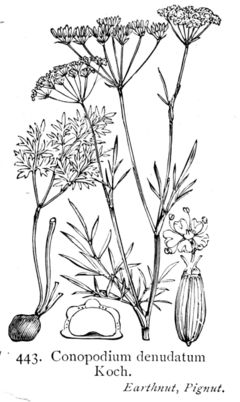- Conopodium majus
-
Conopodium majus 
Scientific classification Kingdom: Plantae Division: Magnoliophyta (unranked): Eudicots Order: Apiales Family: Apiaceae Genus: Conopodium Species: C. majus Binomial name Conopodium majus
(Gouan) Loret.Synonyms Bunium flexuosum Stokes
Conopodium denudatum KochConopodium majus is a small perennial herb, whose underground part resembles a chestnut and is sometimes eaten as a wild or cultivated root vegetable.
The plant has many English names (many of them shared with Bunium bulbocastanum, a related plant with similar appearance and uses) variously including kippernut, cipernut, arnut, jarnut, hawknut, earth chestnut, groundnut, and earthnut. From its popularity with pigs come the names pignut, hognut, and more indirectly Saint Anthony's nut, for Anthony the Great or Anthony of Padua, both patron saints of swineherds. (See groundnut, earthnut, and hognut for other plants which share these names.)
The plant is common through much of Europe and parts of North Africa. It grows in woods and fields, and is an indicator of long-established grassland.
It has a smooth, slender, curving stem, up to 1 m high, much-divided leaves, and small, white flowers in many-rayed terminal compound umbels.
The rounded "nut" (inconsistently described by authorities as a tuber, corm, or root) is similar to a chestnut in its brown colour and its size (up to 25 mm in diameter), and its sweet, aromatic flavour has been compared to that of the chestnut, hazelnut, sweet potato, and Brazil nut. Palatable and nutritious, its eating qualities are widely praised, and it is popular among wild food foragers, but it remains a minor crop, due in part to its low yields and difficulty of harvest.
Culpepper on pignuts
"A description of them were needless, for every child knows them. Government and virtues: They are something hot and dry in quality, under the dominion of Venus; they provoke lust exceedingly, and stir up those sports she is mistress of; the seed is excellent good to provoke urine; and so also is the root, but it does not perform it so forcibly as the seed doth. The root being dried and beaten into powder, and the powder being made into an electuary, is a singular remedy for spitting and pissing of blood, as the former chesnut was for coughs."
Taken from Nicholas Culpeper's Complete Herbal
Shakespeare on pignuts
"I prithee, let me bring thee where crabs grow; and I with my long nails will dig thee pignuts"
-Caliban, The Tempest by William Shakespeare
External links
Categories:- Root vegetables
- Flora of Europe
- Vegetable stubs
Wikimedia Foundation. 2010.

